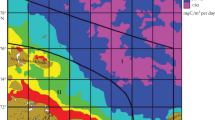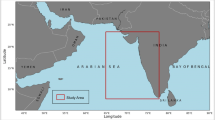Abstract—
Interannual variability (2002–2018) of primary production, surface seawater temperature (T0), photosynthetically active radiation (PAR) and ice cover area in the East Siberian Sea (ESS) was studied based on the data of the MODIS-Aqua ocean color scanner. The annual total primary production (PPtot) decreased by 1.7 TgC over 17 years. The multi-year negative trend in PPtot was 0.1 TgC y–1 (1.38% y–1). The decrease in PPtot was accompanied by the decrease in the area-specific primary production (IPP). Over the investigated period the annual mean IPP decreased by 13 mgC m–2 d–1. The multi-year negative trend in IPP was 0.76 mgC m–2 d–1 y–1 (0.84% y–1). The decrease in PPtot and IPP was accompanied by statistically insignificant increase in T0 (R2 = 0.09) and statistically significant decline in PAR (R2 = 0.29). Over the 17 years, T0 in ESS increased by 0.68°С (0.04°С y–1 or 3.2% y–1) and PAR declined by 3.4 Ein m–2 d–1 (0.2 Ein m–2 d–1 y–1 or 1.9% y–1). The ice-free area slightly diminished during the study period (R2 = 0.10) by 64.94×103 km2. The statistically insignificant negative multi-year trend in the ESS ice-free area was 3.82 × 103 km2 y–1 (0.87% y–1). Long-term variability in PPtot in ESS from 2002 to 2018 depended not only on the decrease in the ice cover but also on PAR level and IPP.






Similar content being viewed by others
REFERENCES
V. E. Borodachev and I. V. Borodachev, “Ice in the Laptev Sea in conditions of climate fluctuations in Arctic,” Probl. Arkt. Antarkt. 109 (3), 60–73 (2016).
A. A. Vetrov and E. A. Romankevich, “Primary production and fluxes of organic carbon to the seabed in the Eurasian arctic seas, 2003–2012,” Dokl. Earth Sci. 454, 44–46 (2014).
A. B. Demidov and V. I. Gagarin, “Primary production and associated environmental conditions in the East Siberian Sea in autumn,” Dokl. Earth Sci. 487, 1006–1011 (2019). https://doi.org/10.1134/S1028334X19080257
A. B. Demidov, V. I. Gagarin, E. G. Arashkevich, et al., “Spatial variability of primary production and chlorophyll in the Laptev Sea in August–September,” Oceanology (Engl. Transl.) 59, 678–691 (2019). https://doi.org/10.1134/S0001437019050047.
A. B. Demidov, V. I. Gagarin, and S. V. Sheberstov, “Seasonal variability and estimation of annual East Siberian Sea phytoplankton primary production and comparison with the other Siberian seas”, Oceanology (Engl. Transl.) 60, 603–616 (2020).
A. B. Demidov, S. V. Sheberstov, and V. I. Gagarin, “Estimation of annual Kara Sea primary production,” Oceanology (Engl. Transl.) 58, 369–380 (2018).
A. B. Demidov, S. V. Sheberstov, and V. I. Gagarin, “Interannual variability of primary production in the Laptev Sea,” Oceanology (Engl. Transl.) 60, 50–61 (2020).
A. D. Dobrovol’skii and V. S. Zalogin, The Seas of USSR (Moscow State Univ., Moscow, 1982) [in Russian].
O. A. Kuznetsova, O. V. Kopelevich, S. V. Sheberstov, et al., “Analysis of the chlorophyll concentration in the Kara Sea according to MODIS–AQUA satellite scanner,” Issled. Zemli Kosmosa, No. 5, 21–31 (2013).
S. V. Sheberstov, “The system of package processing of oceanological satellite data,” Sovrem. Probl. Distantsionnogo Zondirovaniya Zemli Kosm. 12 (6), 154–161 (2015).
K. R. Arrigo and G. L. van Dijken, “Secular trends in Arctic Ocean net primary production,” J. Geophys. Res.: Oceans 116, C09011 (2011). https://doi.org/10.1029/2011JC007151
K. R. Arrigo and G. L. van Dijken, “Continued increases in Arctic Ocean primary production,” Progr. Oceanogr. 136, 60–70 (2015).
J. Aitchison and J. A. C. Brown, “The lognormal distribution,” Econ. J. 67, 713–715 (1957).
D. G. Barber, J. V. Lukovich, Keogak J., et al., “The changing climate of the Arctic,” Arctic 61 (1), 7–26 (2008).
S. Bélanger, M. Babin, and J.-E. Tremblay, “Increasing cloudiness in Arctic damps the increase in phytoplankton primary production due to sea ice receding,” Biogeosciences 10 (6), 4087–4101 (2013).
J. Campbell, D. Antoine, R. Armstrong, et al., “Comparison of algorithms for estimating ocean primary production from surface chlorophyll, temperature and irradiance,” Global Biogeochem. Cycles 16 (3), (2002). https://doi.org/10.1029/2001GB001444
E. Carmack, D. Barber, J. Christensen, et al., “Climate variability and physical forcing of the food webs and the carbon budget on panarctic shelves,” Progr. Oceanogr. 71, 145–181 (2006).
D. J. Cavalieri, C. L. Parkinson, P. Gloersen, and H. J. Zwally, Arctic and Antarctic Sea Ice Concentrations from Multichannel Passive-Microwave Satellite Data Sets: October 1978–September 1995: User’s Guide NASA TM 104647 (Goddard Space Flight Center, Greenbelt, 1997).
J. C. Comiso, “The rapid decline of multiyear ice cover,” J. Clim. 25, (2012). https://doi.org/10.1175/JCLI-D11-00113.1
J. C. Comiso and F. Nishio, “Trends in the sea ice cover using enhanced and compatible AMSR-E, SSM/I, and SMMR data,” J. Geophys. Res.: Oceans 113, C02S07 (2008). https://doi.org/10.1029/2007JC0043257
A. B. Demidov, O. V. Kopelevich, S. A. Mosharov, et al., “Modeling Kara Sea phytoplankton primary production: development and skill assessment of regional algorithms,” J. Sea Res. 125, 1–17 (2017).
P. Falkowski, “Light-shade adaptation and assimilation numbers,” J. Plankton Res. 3, 203–216 (1981).
R. Frouin, J. McPherson, K. Ueyoshi, and B. A. Franz, “A time series of photosynthethetically available radiation at the ocean surface from SeaWiFS and MODIS data,” Proc. SPIE 12, (2012). https://doi.org/10.1117/1112.981264
V. J. Hill, P. A. Matrai, E. Olson, et al., “Synthesis of integrated primary production in the Arctic Ocean: II. In situ and remotely sensed estimates,” Progr. Oceanogr. 110, 107–125 (2013).
Remote Sensing of Ocean Color in Coastal and Other Optical-Complex Waters, Ed. by S. Sathyendranath (International Ocean-Color Coordinating Group, Dartmouth, 2000).
M. Kahru, Z. Lee, B. G. Mitchell, and C. D. Nevison, “Effects of sea ice cover on satellite-detected primary production in the Arctic Ocean,” Biol. Lett. 12, (2016). https://doi.org/10.1098/rsbl.2016.0223
R. Kwok, G. F. Cunningham, M. Wensnahan, et al., “Thinning and volume loss of Arctic sea ice: 2003–2008,” J. Geophys. Res.: Oceans 114, C07005 (2009). https://doi.org/10.1029/2009JC005312
E. Leu, J. E. Søreide, D. O. Hessen, et al., “Consequences of changing sea-ice cover for primary and secondary producers in the European Arctic shelf seas: timing, quantity, and quality,” Progr. Oceanogr. 90, 18–32 (2011).
K. M. Lewis, B. G. Mitchell, G. L. van Dijken, and K. R. Arrigo, “Regional chlorophyll a algorithms in the Arctic Ocean and their effect on satellite-derived primary production estimates,” Deep Sea Res., Part II 130, 14–27 (2016).
A. Longhurst, S. Sathyendranath, T. Platt, and C. Caverhill, “An estimate of global primary production in the ocean from satellite radiometer data,” J. Plankton Res. 17 (6), 1245–1271 (1995).
S. Pabi, G. L. van Dijken, and K. R. Arrigo, “Primary production in the Arctic Ocean, 1998–2006,” J. Geophys. Res.: Oceans 113, C08005 (2008). https://doi.org/10.1029/2007/JC004578
V. K. Pavlov, L. A. Timokhov, G. A. Baskakov, et al., Hydrometeorological regime of the Kara, Laptev, and East-Siberian Seas: Technical Memorandum APL-UWTM1-96 (Applied Physics Laboratory University of Washington, Washington, 1996).
D. Petrenko, D. Pozdnyakov, J. Johannessen, et al., “Satellite-derived multi-year trend in primary production in the Arctic Ocean,” Int. J. Remote Sens. 34, 3903–3937 (2013).
S. Pivovarov, R. Schlitzer, and A. Novikhin, “River run-off influence on the water mass formation in the Kara Sea,” in Siberian River Run-Off in the Kara Sea, Ed. by R. Stein, (Elsevier, Amsterdam, 2003), pp. 9–25.
R. W. Reynolds, T. M. Smith, C. Liu, et al., “Daily high-resolution-blended analyses for sea surface temperature,” J. Clim. 20 (22), 5473–5496 (2007).
M. Steele, W. Ermold, and J. Zhang, “Arctic Ocean surface warming trends over the past 100 years,” Geophys. Res. Lett. 35, L02614 (2008). https://doi.org/10.1029/2007GL031651
J. Stroeve, M. Holland, W. Meier, et al., “Arctic sea ice decline: faster than forecast,” Geophys. Res. Lett. 34, L09501 (2007). https://doi.org/10.1029/2007GL029703
J. C. Stroeve, V. Kattsov, A. P. Barrett, et al., “Trends in Arctic sea ice extent from CMIP5, CMIP3 and observations,” Geophys. Res. Lett. 39, L16502 (2012). https://doi.org/10.1029/2012GL052676
J. C. Stroeve, M. C. Serreze, M. M. Holland, et al., “The Arctic’s rapidly shrinking sea ice cover: a research synthesis,” Clim. Change 110, 1005–1027 (2012).
M.-L. Timmermans and C. Ladd, Sea surface temperature, Arctic Report Card: update for 2018. https://arctic. noaa.gov/Report-Card-2018/ArtMID/7878/ArticleID/ 779/Sea-Surface-Temperature.
J.-É. Tremblay, S. Bélanger, D. G. Barber, et al., “Climate forcing multiplies biological productivity in the coastal Arctic Ocean,” Geophys. Res. Lett. 38, L18604 (2011). https://doi.org/10.1029/2011GL048825
J.-É. Tremblay, C. Michel, K. Hobson, et al., “Bloom dynamics in early opening waters of the Arctic Ocean,” Limnol. Oceanogr. 51 (2), 900–912 (2006).
J.-É. Tremblay, D. Robert, D. E. Varela, et al., “Current state and trends in Canadian Arctic marine ecosystems: I. Primary production,” Clim. Change 115, 161–178 (2012).
M. Vancoppenolle, L. Bopp, G. Madec, et al., “Future Arctic Ocean primary productivity from CMIP5 simulations: uncertain outcome, but consistent mechanisms,” Global Biogeochem. Cycle 27, 605–619 (2013). https://doi.org/10.1002/gbc.20055
J. J. Walsh, et al., “A numerical model of seasonal primary production within the Chukchi/Beaufort seas,” Deep Sea Res., Part II 52 (24–26), 3541–3576 (2005).
P. Wassmann, C. M. Duarte, S. Agustí, and M. K. Sejr, “Footprints of climate change in the Arctic marine ecosystem,” Global Change Biol. 17 (2), 1235–1249 (2010). https://doi.org/10.1111/j.1365-2486.2010.02311.x
P. Wassmann, D. Slagstad, and I. Ellingsen, “Primary production and climatic variability in the European sector of the Arctic Ocean prior to 2007: preliminary results,” Pol. Biol. 33, 1641–1650 (2010).
J. Zhang, Y. H. Spitz, M. Steele, et al., “Modeling the impact of declining sea ice on the Arctic marine planktonic ecosystem,” J. Geophys. Res.: Oceans 115, C10015 (2010). https://doi.org/10.1029/2009/JC005387
ACKNOWLEDGMENTS
We are grateful to GSFC DAAC (Goddard Space Flight Center, Distributed Active Archive Center), NASA, for the opportunity to use satellite data from the MODIS-Aqua scanner, NODC (National Oceanographic Data Center) NOAA for access to hydrophysical data, and NSIDC (National Snow and Ice Data Center) NOAA for the data on the ice cover area.
Funding
The study was performed within the framework of a state assignment of the Ministry of Science and Higher Education of the Russian Federation (project no. 0149-2019-0008). The field studies and satellite data processing were supported by the Russian Foundation for Basic Research (grant no. 18-05-60069 “Arctic”).
Author information
Authors and Affiliations
Corresponding author
Additional information
Translated by N. Ruban
Rights and permissions
About this article
Cite this article
Demidov, A.B., Gagarin, V.I. & Sheberstov, S.V. Interannual Variability of Primary Production in the East Siberian Sea. Oceanology 60, 765–777 (2020). https://doi.org/10.1134/S0001437020050033
Received:
Revised:
Accepted:
Published:
Issue Date:
DOI: https://doi.org/10.1134/S0001437020050033




